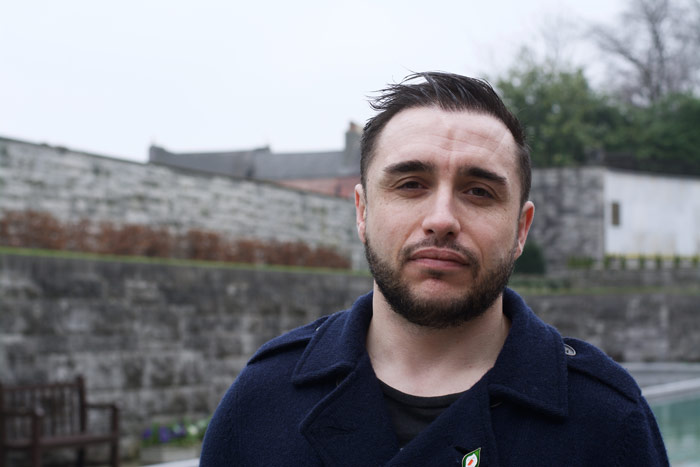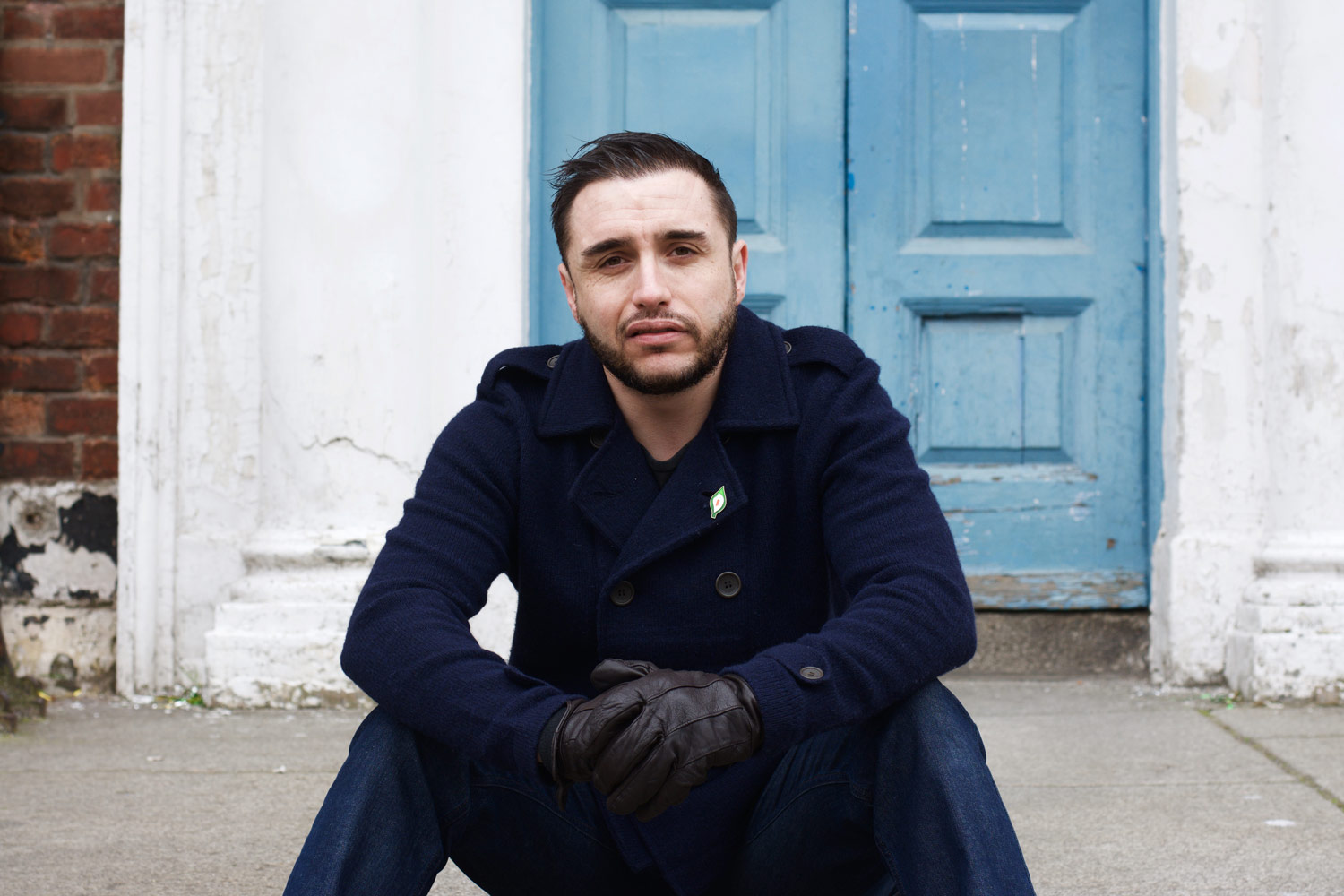Frankie Gaffney, author of Dublin Seven, muses as he looks fondly over the landscape of the Garden of Remembrance. “I used to go on the mitch here.” Gaffney has chosen the epicenter of Irish historical commemoration as a spot for our photo shoot as that his old gaelscoil, Colaiste Mhuire, was located just across the road. It is a bright crisp morning, elegantly showcasing the Dublin metropolis in all its glory, with the water of the cross-shaped pond glistening in the morning light as seagulls soar overhead and workers eager for the upcoming long weekend hurry past the garden’s gates.
However, the Dublin reality in Gaffney’s book is not quite so picturesque. Yes, Dublin is a beautiful modern city, but it is a city like any other, with two sides, the underbelly of which operates on a potent diet of crime and drugs. In light of recent Dublin gangland feuds, the workings of this alternative world became visible. A world that previously hardly existed beyond the odd hushed passing of substances on street corners for the vast majority, suddenly erupted into the public sphere with news of successful shootings and foiled hits. Dramatic headlines and garda stop points captivated public imagination, as what once only played out on our television screens broke out on our streets. It is a world that most of us observe without any insight or understanding. In his book, Frankie Gaffney gives us an insight into this universe and through his protagonist Shane, the manner in which the ordinary individual becomes ensnared in its web.
Gaffney feels qualified to write about gangland activity given his own background. He knows only too well the impact that drug culture has had on the city, with his own father having spent time in prison for drug-related offences when he was a child. A move to the inner city coincided with Gaffney’s entry into young adulthood and in this environment he observed much of the social issues raised in the book. The teenage Gaffney was politically minded and involved in many groups, the anti-drug movement among them. However, in his early 20s, he diverted onto a different course. While he’s willing to acknowledge this path, it’s clear that he’s not entirely comfortable talking about. It was during these socially formative years that he garnered much of the material for the book that he had intended to write since his youth, seeking to produce an accurate and honest depiction of the impact of the drug trade on the inner city. “I felt that I was qualified to write about the Dublin underworld and gangland and stuff in a way that other people that had been writing about it and talking about it aren’t, because I’ve lived in that world”, he says.
SYNOPSIS
Dublin Seven follows 18-year-old school leaver Shane as he socialises and begins post-secondary education. Shane is a typical young lad, harboring insecurities characteristic of his age group while holding a natural and untapped gift for maths. However, when Shane meets local drug dealer Griffo with his flash clothes, effortlessly cool attitude and thriving cocaine business, the young man sees the benefits of earning quick money. The arrival of the first installment of a college grant in his account seems to offer Shane endless possibilities he could previously only have dreamt of, as he pockets more money than he has ever seen in his life. The enterprising Shane joins the circuit of buying and selling, and events spiral from there, encompassing a wide variety of social issues and exploring the inner workings of gangland culture and its impacts.
RELATIONSHIP WITH LITERATURE
Settling himself down in a local cafe, Gaffney immediately stresses the anchor that literature has been for him in his life and he credits books as preventing him from going down the same route as his novel’s protagonist. His mother, who he says ran a “very, very, very, feminist household”, always provided him with books. He recalls: “Growing up, I read all the time. My ma always encouraged me to read and I think to a large extent people read the book as autobiographical but I think the fact that my ma encouraged me to read and that kind of thing is one of the reasons that I don’t end up like the character in the book.” He looks back fondly on a childhood filled with “Roald Dahl, the usual CS Lewis” and even a “penchant for female black authors” around the age of 10 when he “started reading Maya Angelou and The Colour Purple”. Now pursuing a PhD exploring English linguistics entitled “Looking at the Novel”, literature and more specifically language itself plays a central role in Gaffney’s life.
LOVE/HATE
Given Gaffney’s chosen subject matter, many were quick to compare Dublin Seven with the recent fictional gangland series Love/Hate. Although Gaffney enjoyed Love/Hate like the rest of us, he found numerous problems with the series in terms of its depiction of the inner city and its inhabitants. “If I was making drama about Johannesburg, I wouldn’t cast white actors in the roles and get them to put on blackface”, he argues. “It’s like linguistic blackface”, he explains of the decision to cast actors with origins outside of the inner city. “There’s 500,000 people here that speak the dialect I speak. Why wouldn’t you cast them if you’re making a drama about that city? For me it seems discriminatory”, he finishes.

RODDY DOYLE
Naturally, given the setting of his book, much comparison has also been drawn between his work and that of Roddy Doyle and his Dublin-based books, The Snapper and The Van. Although Gaffney said that as a teen he read and reread the works of Doyle, he found some issues within his text: “I don’t agree with or like the way he represents Dublin English. He puts in apostrophes for deviations away from standard English. So if he drops a g he will have fuckin’ with no g”. Gaffney adds: “Roddy Doyle – he won’t use compound words either like ‘yerman’. He’ll put y-o-u-r space m-a-n, whereas really that’s not the word. It’s not how it’s pronounced and it’s not two separate words like that in the dialect so I put y-e-r-m-a-n and I think that the dialect should be rendered as it is so I think those kind of choices have kind of politico-linguistic implications.” This interest in the correct depiction of language was what sparked his interest in his PhD topic after writing an undergraduate essay on the work of Doyle.
THE GARDAÍ
The relationship between the gardaí and those involved in the Dublin drug scene has naturally been rather turbulent. “The phrase ‘known to gardaí’ is very significant in the book and to me I find that incredibly offensive. I think it’s a vile euphemism – it just means he deserved it”, Gaffney argues. In terms of relations with the gardaí, Gaffney does not have fond memories of the force as a youngster. “I remember, when I was a young fella, just overwhelmingly negative interactions with the police”, he says. “I remember asking to see one of their IDs and he hit me in the face for asking to see his ID.” While he declares there to be “an epidemic of corruption” in the gardaí, he does feel fonder of them now than he once did, though he attributes this to his age and neater form of dress. “Someone sent me pictures of [my book] being read in a garda office … I think they’ll recognise it and realise that it’s realistic”, he says grinning.
MEDIA PORTRAYAL
Recent months have seen the appearance of mountains of articles emblazoned with gangland references, to the point where “The Monk” has once more become a household name. Gaffney has long observed this media frenzy and the accompanying public fascination with these narratives with growing unease. He notes how, in the past, “journalists like Paul Williams and Veronica Guerin as well, … were making a name for big-time criminals, glamorising them with nicknames” and warns of the danger of “driving those people’s reputations and sensationalising it and making it attractive to young people to get involved in that life”.
He also feels that the very depiction of gangland society in the media is inaccurate: “The media portray them as these kind of very militaristically run rigid hierarchies that are controlled and that there are feuds over turf and that’s absolute nonsense, selling stuff to people. Like, it’s an unregulated free market and that’s all it is.” It seems that Gaffney’s illustration was more true to life as “a few gangsters got in touch with [him] as well and said ‘ah this is realistic.” However, he is cautious of this praise: “I suppose I don’t like to think of them liking it in a sense that I don’t try and portray them as saints or as guilt free or anything or to make that life look attractive, or anything like that.” However, he does reflect that “when you represent something in artistic form it makes it give it a legitimacy and it makes it attractive to an extent”.
His success in mapping gangland Dublin is largely down to his mantra that “if you’re going to talk about these issues, you have a duty to try and understand the reasons behind people’s actions rather than just dramatise and sensationalise”.
THINGS NEED TO CHANGE
In his educational journey, Gaffney has become concerned about the inequalities that exist in our education system, which sees many young people fall by the wayside. He points out how “there’s a lot of focus on gender equality, let’s say. But in comparison, I think the focus on class issues is negligible at best”. He continues: “You have an area like Dublin 17. 15 per cent progress to higher education and then in Dublin 6 99 per cent do. So compare that to the gender disparity and it pales in significance. It’s apartheid in the city and it’s invisible and it’s not being discussed.” He is disgusted, saying: “This is absolutely shocking and I cannot believe it’s not being screamed from the rooftops – this disparity.” He says that he based the characters on the kids he met while doing a course in Ballyfermot: “All of those young people dropped out and these are bright smart young kids, but they just weren’t able or interested in the academic side of it. [They were] so absolutely capable and that’s who I had in my head when I was writing the book. A whole lot of them were selling drugs, getting deeper into it. They’ve given me very positive feedback on it and said that it’s a very true and accurate representation of them.”
THE FUTURE
As for the future, given Dublin Seven is only the first installment of his two-part book deal, we can expect to see more from him. He comments that, though he had planned on writing a second book set in the academic world in England, there is such demand for another Dublin-based novel that he may have to reconsider and accept public demand. Gaffney stresses the importance of introducing authors of a different socioeconomic background like himself to publishing, saying: “The publishing industry is overwhelmingly middle class but the people that buy books aren’t. You know working class people buy books by the ton.” Regardless of what he writes next, he has a PhD to finish first.







